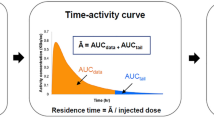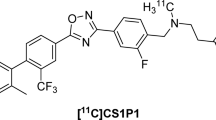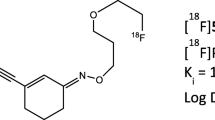Abstract
[18F]1-(2-Fluoroethyl)-4-[(4-cyanophenoxy)methyl]piperidine ([18F]SFE) is a novel, selective, high-affinity sigma-1 receptor radioligand that has been preclinically well characterized in rodents. To support an investigational new drug (IND) application for the first evaluation of [18F]SFE in humans, single-organ and whole-body radiation adsorbed doses associated with [18F]SFE injection were estimated from rat distribution data. In addition, single- and multiple-dose toxicity studies were conducted in rabbits and in dogs. Multiple-dose toxicity studies in rabbits and single-dose toxicity studies in beagles suggest at least a 100-fold safety margin for humans studies at a mass dose limit of 4.0 μg per intravenous injection, based on the combined no observable adverse effect levels (NOAEL, mg/m2) measured in these species. Radiation dosimetry estimates obtained from rat biodistribution analyses of [18F]SFE suggest that most tissues would receive about 0.010–0.020 mGy/MBq, while the adrenal glands, brain, bone, liver, lungs, and spleen would receive slightly higher doses (0.024–0.044 mGy/MBq). The adrenal glands were identified as the critical organ, because they received the highest adsorbed radiation dose. The total exposure resulting from a 5 mCi administration of [18F]SFE is well below the FDA-defined limits for yearly cumulative and per-study exposures to research participants. These combined results support the expectation that [18F]SFE will be safe for use in human positron emission tomography (PET) imaging studies with the administration of 5 mCi and a mass dose equal to or less than 4.0 μg SFE per injection.
Similar content being viewed by others
References
Bermack JE, Debonnel G (2005) The role of sigma receptors in depression. J Pharmacol Sci 97(3):317–336
Guitart X, Codony X, Monroy X (2004) Sigma receptors: Biology and therapeutic potential. Psychopharmacology 174(3):301–19
Romieu P, et al. (2004) The sigma1 (sigma1) receptor activation is a key step for the reactivation of cocaine conditioned place preference by drug priming. Psychopharmacology 175(2):154–62
Matsumoto RR, et al. (2003) Sigma receptors: Potential medications development target for anti-cocaine agents. Eur J Pharmacol 469(1–3):1–12
Vilner BJ, John CS, Bowen WD (1995) Sigma-1 and sigma-2 receptors are expressed in a wide variety of human and rodent tumor cell lines. Cancer Res 55(2):408–413
Waterhouse RN, et al. (2004) First evaluation of the sigma-1 receptor radioligand [18F]1-3-fluoropropyl-4-((4-cyanophenoxy)-methyl)piperidine ([18f]fps) in healthy humans. Neuroreceptor Mapping 2004, July 15–18th, Vancouver, BC Canada
Waterhouse RN, et al. (2006) In vivo evaluation in rats of [18F]1-(2-fluoroethyl)-4-[(4-cyanophenoxy)methyl]piperidine ([18F]SFE) as a potential radiotracer for PET assessment of brain sigma-1 receptors. Nucl Med Biol 33(2):211–215
Zhao J, et al. (2005) Radiosynthesis and in vivo study of [18F]1-(2-flouroethyl)-4-[(4-cyanophenoxy)methyl]piperidine as a novel sigma-1 receptor ligand. J Labelled Compd Radiopharm 48(8):547–555
Simpson MD, et al. (1991) Alterations in phencyclidine and sigma binding sites in schizophrenic brains. Effects of disease process and neuroleptic medication. Schizophr Res 6(1):41–8
Skuza G, Wedzony K (2004) Behavioral pharmacology of sigma-ligands. Pharmacopsychiatry 37(3)
Kirschner A, Ice R, Beierwaltes W (1975) Radiation dosimetry of 131I-19-iodocholesterol: The pitfalls of using tissue concentration data, the author's reply. J Nucl Med 16(3):248–249
Christy M, Eckerman K (1987) Specific absorbed fractions of energy at vaious ages from internal protons sources. ORNL/TM-8381 V1–V7. Oak Ridge National Laboratory, Oak Ridge, TN
Loevinger R, Budinger T, Watson E (1988) MIRD Primer for Absorbed Dose Calculations, Society of Nuclear Medicine
Stabin MG, Sparks RB, Crowe E (2005) OLINDA/EXM: The second-generation personal computer software for internal dose assessment in nuclear medicine. J Nucl Med 46(6):1023–1027
Waterhouse RN, Stabin MG, Page JG (2003) Preclinical acute toxicity studies and rodent-based dosimetry estimates of the novel sigma-1 receptor radiotracer [(18)F]FPS. Nucl Med Biol 30(5):555–563
Acknowledgments
The preclinical development of [18F]SFE was funded by the National Institutes of Health (1RO1 NS40402), with exception of the toxicology studies. Toxicology studies were entirely funded by the Department of Health and Human Services, National Institutes of Health, National Institute of Mental Health, under contract no. N01MH32001.
Author information
Authors and Affiliations
Corresponding author
Rights and permissions
About this article
Cite this article
Waterhouse, R.N., Zhao, J., Stabin, M.G. et al. Preclinical Acute Toxicity Studies and Dosimetry Estimates of the Novel Sigma-1 Receptor Radiotracer, [18F]SFE. Mol Imaging Biol 8, 284–291 (2006). https://doi.org/10.1007/s11307-006-0056-1
Published:
Issue Date:
DOI: https://doi.org/10.1007/s11307-006-0056-1




